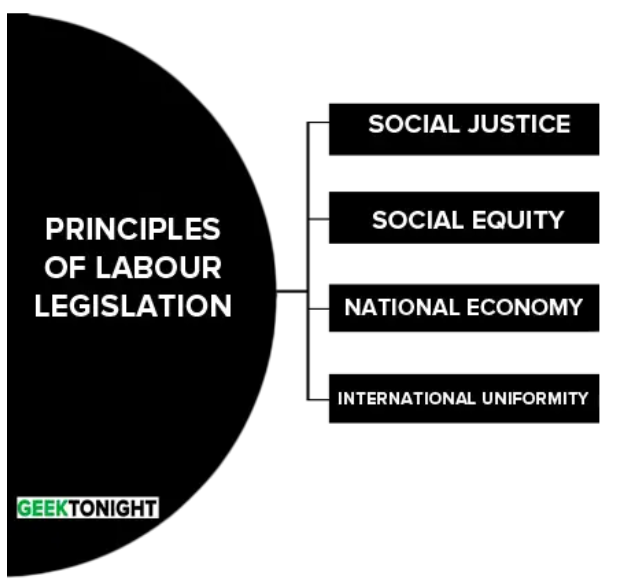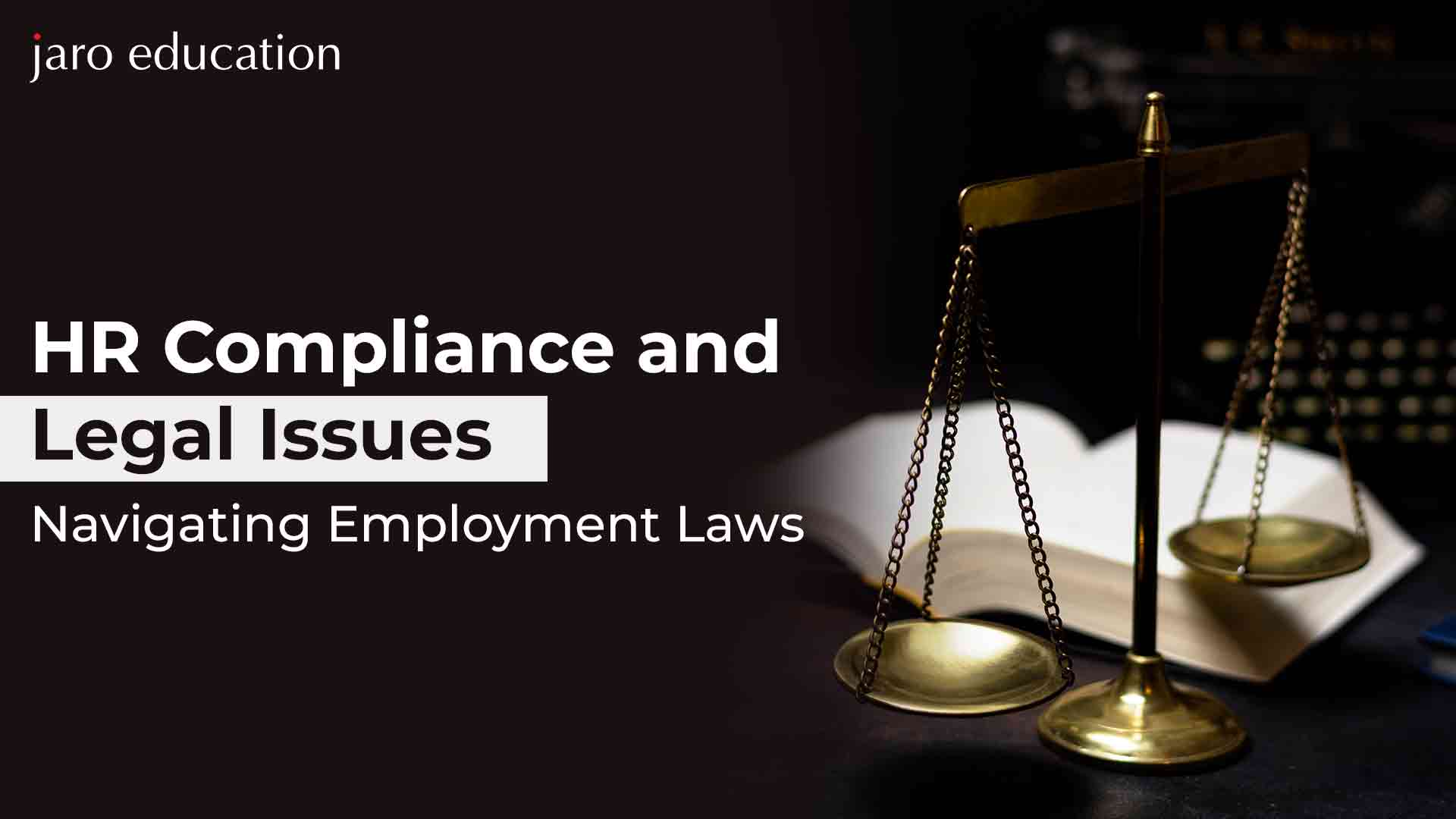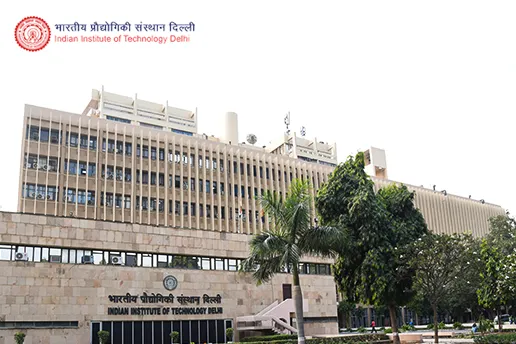
- jaro education
- 16, January 2024
- 9:00 am
Organizations thrive when technology and people work together. Wage employment is a common feature in industrial societies, and in a country like India, many seek better job opportunities and industrial standards.
Managing people for an organization is challenging. It’s crucial for a healthy workplace. If mismanaged, the employee-employer relationship can lead to misunderstandings and a toxic work culture. This often results in higher turnover, increased indiscipline, decreased output, and higher production costs.
Industrial relations involve the relationships between unions, states, employers, and the government. Employment laws, which include industrial and labour laws, govern the rules for working individuals and their organizations. Labour laws specifically cover industrial relations and related matters.
In this blog, we will learn about labour laws and industrial relations and how they are important to shape the workplace and impact the broader socio-economic landscape.
What are Labour Laws?
Table of Contents
Labour law consists of rules that outline employers’ and employees’ duties and rights. These regulations vary by location, and the explanation here focuses on labour law in India.
In the past, when factories and industries started growing, bosses took advantage of workers. They treated workers as replaceable and only cared about making the most money. The idea was that if a boss took risks, they had the right to hire or fire workers. The law back then also treated workers like servants, and the terms of work were usually just spoken and not written down. If workers broke the rules, they could be taken to court.
As time went on, the purpose of labor laws changed. At first, these laws were made to protect the interests of employers. This was based on the idea that the government should stay out of people’s business as much as possible. But now, modern labor laws focus on making sure workers are not taken advantage of by their bosses. This shift comes from a new way of thinking that believes in taking care of people, called the welfare state doctrine. The old ideas of easily hiring and firing workers and letting the market decide everything are no longer accepted.
Here are some examples of labour laws in India:
1. Industrial Disputes Act, 1947
Aims to maintain peace and harmony in industries by resolving conflicts through conciliation, arbitration, and adjudication.
2. Minimum Wages Act, 1948
Mandates contractors to pay their workers a minimum wage and ensures double wages for overtime work.
3. Factories Act, 1948
Regulates working conditions in factories, covering aspects such as health, safety, and overall welfare.
4. Employees’ Provident Funds and Miscellaneous Provisions Act, 1952
Requires establishments with over 20 employees to have a provident fund. In this scheme, employees contribute 12% of their wages, and employers contribute an equal amount.
Importance of Labour Laws
Labour laws play a crucial role in improving the working conditions of employees. It’s important to recognize that these laws offer various benefits, not only for employees but also for employers, contractors, and society as a whole. Over time, labour laws have evolved and changed to stay relevant to changes in different industries, wages, skills, and living standards.
Rights of Employees and Employers
Labour laws, including the Employees’ Provident Fund (EPF) and contract labour laws, act as regulators, ensuring fair work practices. They establish guidelines that define employers’ and employees’ rights and responsibilities, fostering a smooth work culture in society. Employers are encouraged to provide a better work environment, while employees are ensured the right to a safe and conducive workplace, along with rights related to leaves, wages, and provident funds.
Prevention of Child Labor
Labour laws play a vital role in preventing child labour, recognizing that it goes against the principles of a welfare state. These laws prohibit the employment of children below a certain age to safeguard their right to education. Any entity, be it a company, an individual, or a contractor, hiring such children is deemed illegal. This ensures the protection of children and their rights.
Proper Compensation and Reasonable Hours
Employees often find themselves in situations where they have limited income sources, making them vulnerable to exploitation. Labour laws, such as the EPF Act and Minimum Wages Act, set standards for compensation, ensuring that workers receive a fair amount for specific jobs or work hours. This benefits both employers, who can plan their hiring costs, and employees, who can anticipate their earnings.
Prevention of Discrimination
Labour laws promote equal work opportunities, discouraging discrimination based on factors such as caste, creed, sex, religion, or race. They ensure a fair and unbiased job selection process, fostering inclusivity and equal opportunities for everyone.
Prevention of Exploitation
Some employers take advantage of vulnerable workers, particularly women and children. labour laws are designed to protect the interests of such workers by establishing guidelines for safe work conditions. These laws also mandate safety tools and regulations for specific worker categories, ensuring their well-being.
Better Work Environment and Social Justice
Acts like the EPF and Contract Labour Act contribute to a positive work environment, benefiting organizations of all sizes. These laws call for necessary provisions that make work smoother for both employers and employees. Additionally, EPF helps individuals save for the future, providing financial security during unexpected situations.

*geektonight.com
Elements of Labour Law
Labour law covers nine main areas: employment, individual work relationships, salary, working conditions, health and safety, social security, trade unions, and workplace relations, labour law administration, and special rules for specific occupations or groups.
1. Employment
Employment was initially focused on preventing excessive unemployment before the Great Depression, but contemporary labour laws emphasize creating job opportunities for economic stability.
2. Individual Employment Relations
The historical concept of master and servant relationships in labour law involved contractual obligations, with evolving statutes limiting freedom of contract, especially in areas like termination, dismissal procedures, minimum wages, and social security rights.
3. Wages and Remuneration
Substantive wage laws cover payment methods, protection against unlawful deductions, minimum wage arrangements, and income policies as deliberate instruments for economic stability and growth.
4. Conditions of Work
This aspect of labour law, rooted in Industrial Revolution protections, addresses work hours, rest periods, vacations, child labour prohibition, young persons’ employment regulation, and special provisions for women, adapting to modernized sectors and changing social norms.
5. Health, Safety, and Welfare
Occupational health, accident prevention, and regulations, including specific rules for hazardous jobs like mining and construction, constitute the health, safety, and welfare aspect of labour law. This also covers poisons, machinery, dust, noise, vibration, and radiation risks.
6. Social Security
Social security in labour law ranges from employers’ liability for accidents to comprehensive schemes covering sickness, unemployment, retirement, injury, maternity, family, invalidity, survivors’ benefits, and medical care.
7. Trade Unions and Industrial Relations
Industrial relations in labour law involve legal aspects of trade unions, employers’ organizations, collective bargaining, agreements, representation of employees, joint consultation, codetermination, workers’ participation, and the prevention and settlement of labour disputes.
8. Administration of Labour Law
Labour law administration involves the organization and functioning of authorities like labour departments, inspection services, and other enforcement organs. It also encompasses labour courts for settling grievances and industrial disputes between labour and management.
9. Special Categories of Workers
Labour law includes provisions for specific occupational groups, often as parts of a general code or special legislation. This is common in sectors like mining, transportation, commerce, and agriculture and involves distinctions between blue-collar workers, salaried employees, and other employment categories.
What is Industrial Relations?
Industrial relations refer to how workers behave in the organizations where they work. Scholars studying industrial relations aim to understand differences in work conditions, how much say workers have in decision-making, the role of unions and other ways workers are represented, and how conflicts between workers and employers are resolved. They look at how these interactions affect the outcomes of organizations, including things like worker satisfaction, job security, organizational efficiency, and the impact on the community and society. The key roles of industrial relations include:
- Facilitating communication between workers and management for a positive relationship.
- Fostering collaboration between managers and employees.
- Harnessing the positive influence of trade unions to prevent conflicts.
- Protecting the interests of both workers and management.
- Preventing an unhealthy and unethical environment in the industry.
- Developing measures that promote understanding, creativity, and cooperation to boost industrial productivity.
- Ensuring increased participation by workers.
Importance of Positive Industrial Relations
1. Promoting Democracy
Industrial relations involve using collective bargaining to address workers’ issues. This process relies on cooperation and mutual agreement among all parties involved—democracy in action. This includes management and employee unions working together to establish industrial democracy, encouraging workers to contribute their best to the organization’s growth and prosperity.
2. Boosting Morale
Positive industrial relations elevate employee morale, inspiring them to work more efficiently.
3. Preventing Conflicts Between Management And Union
Industrial relations help prevent conflicts between unions and management by setting up mechanisms to resolve issues through mutual agreement. Both parties are bound to this agreement, reducing the likelihood of unfair practices and major conflicts between employers and trade unions.
4. Reducing Wastage
Maintaining satisfactory industrial relations is based on cooperation and mutual recognition within the department. This approach helps minimize wastage of material, manpower, and costs.
5. Fostering Economic Growth And Development
Healthy and harmonious industrial relations lead to increased efficiency, prosperity, and reduced turnover, providing tangible benefits to the organization. This, in turn, contributes to economic growth and development.
As an HR Expert in any company, one must be aware of labour laws and industrial relations. If you are a fresh graduate and seeking a career in HR management, you must check the Executive Programme in Human Resource Management by IIT Delhi. By blending theoretical concepts with practical applications, the program seamlessly integrates HR principles and analytics to enhance organizational effectiveness. Its goals encompass establishing a strong groundwork in HR basics, fostering talent management proficiency, honing skills in HR data analysis, cultivating leadership capabilities, and offering insights into HR law and ethics. This initiative empowers professionals to thrive in the field of HR management.
Industrial Relations and Labour Laws in India: Navigating the Current Landscape
The current state of industrial relations and labour laws in India is shaped by the ongoing developments and expansion in the industrial sector. The growth in this sector has brought about a significant impact on the employment landscape, influencing the economic conditions of workers and their relationship with organizations. Understanding the intricacies of these laws is not a one-size-fits-all approach; rather, it requires a thorough examination of empirical and statistical data to comprehend the nuances of labour policies.
Each industry operates under specific rules and regulations that necessitate compliance with both national and regional laws and policies. On 28th September 2020, the Industrial Relations Code 2020 received the president’s assent. This legislative move aimed to consolidate the Industrial Disputes Act of 1947, the Industrial Employment (Standing Orders) Act of 1946, and the Trade Unions Act of 1926. The overarching goal of this code was to bring about benefits for both employers and employees. Here are some advantages of the Industrial Relations Code 2020:
- Enhancing the efficiency of dispute resolution processes to facilitate amicable solutions and preserve the employer-employee relationship.
- Safeguarding employees with fixed-term contracts, ensuring protection for those engaged in specific-duration employment.
- Enforcing compliance with established standing orders within industrial establishments.
- Imposing stringent penalties on authorities failing to adhere to regulations, addressing non-compliance issues effectively.
- Fostering a business-friendly environment and providing employers with increased flexibility in decision-making for smoother operations.
Conclusion
The state of Indian industrial relations is evolving without conforming to specific patterns like tripartite or bipartite systems. Initially, internal and external factors posed challenges, but India has made progress in developing and enhancing industrial relations. When issues arise, management employs various approaches to address them. Effectively managing conflicts is crucial for organizational growth, as poor industrial relations can lead to decline.
The contributions of labour and workers are vital for organizational success, and their rights are now protected. Reforms aim to streamline labour procedures, making them simpler and more transparent. Fewer, concise laws benefit both employers and employees, fostering a more employment-friendly environment. Simplified codes can boost global investments in India’s industrial sector, elevating the country’s global standing and supporting initiatives like Make in India.







